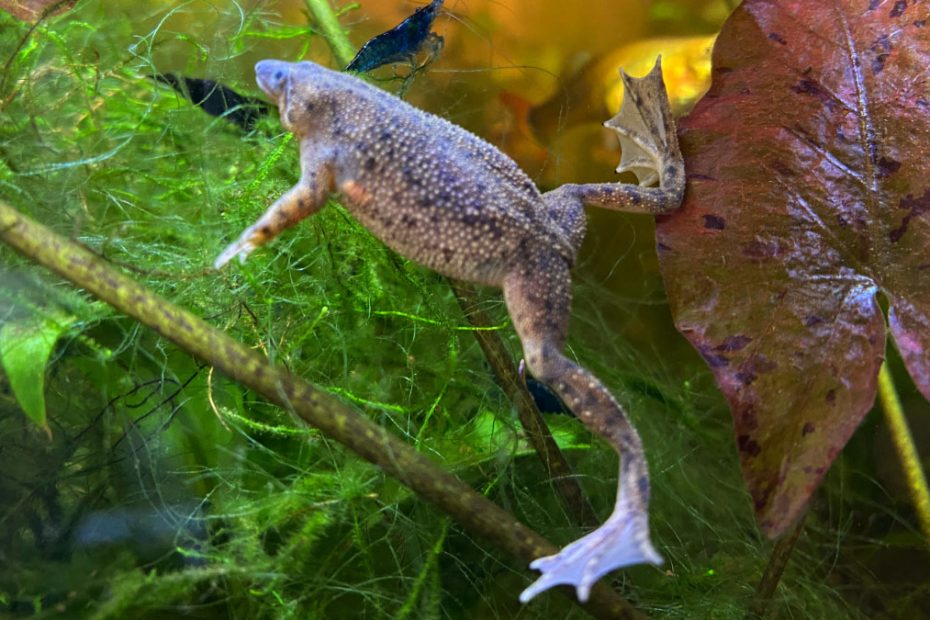African dwarf frogs, scientifically known as Hymenochirus, are fascinating and tiny amphibians that have gained popularity as aquatic pets. Their petite size and endearing appearance make them an excellent choice for hobbyists and beginners alike. But how do you identify them?
What are the signs of African dwarf frog? These frogs are small aquatic creatures, measuring 1-2.5 inches on average. They have webbed feet, smooth skin, and intriguing behaviors like burbling and social tendencies.
Read on to explore their physical attributes, behaviors, and habitat preferences right below.
Table Summarizing All The Signs Of African Dwarf Frogs
Here is a table showing all the attributes you need to know to differentiate them from other amphibians.
| Sign | Description |
|---|---|
| Size | 1-2.5 inches on average, with males 40% smaller |
| Feet | Four webbed feet with strong hind limbs and tiny black claws |
| Color | Typically brown or olive green with dark spots |
| Eyes | Small, lateral eyes with limited eyesight |
| Skin | Smooth, soft, and permeable |
| Head | Flattened head, pointed snout, with no ears or teeth |
| Shy Nature | Prefers solitude, hides among vegetation |
| Burbling | Floating motionlessly beneath the water’s surface |
| Activity Patterns | Nocturnal |
| Social Preference | Thrives in groups and can coexist with tropical fish |
| Molting | Sheds skin and may consume it |
| Feeding Habits | Omnivorous |
| Vocalization | Males hum to attract females during mating |
| Aquatic Lifestyle | Fully aquatic, briefly surfacing for air |
| Habitat Preference | Marshes, slow rivers, shallow ponds |
| Lifespan | Up to 5 years in the wild, but up to 20 in captivity |
Physical Signs Of African Dwarf Frogs
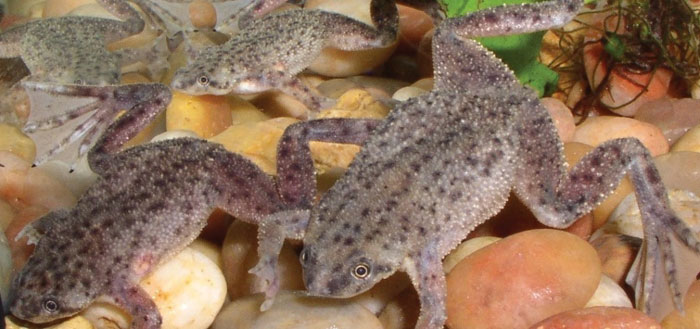
These frogs have physical attributes that can help you differentiate them from other frogs. Here’s a delve into these attributes:
1. Size
African Dwarf Frogs, as their name suggests, are really small amphibians. On average, they measure 1-2.5 inches in length, with some reaching up to 3 inches. Notably, males are roughly 40% smaller than females.
2. Feet
A distinctive feature of these frogs is their four webbed feet, with strong and flattened hind limbs. Their hind legs also have tiny black claws to help them hold their prey. These specialized feet also allow them to navigate their aquatic environments with ease.
3. Color
In their natural habitat, African dwarf frogs typically sport earthy hues, primarily brown or olive green. Their skin color is also adorned with dark spots that serve as a form of camouflage.
However, in captive breeding, enthusiasts have developed color variations, such as gold and albino, adding a vibrant touch to these frogs.
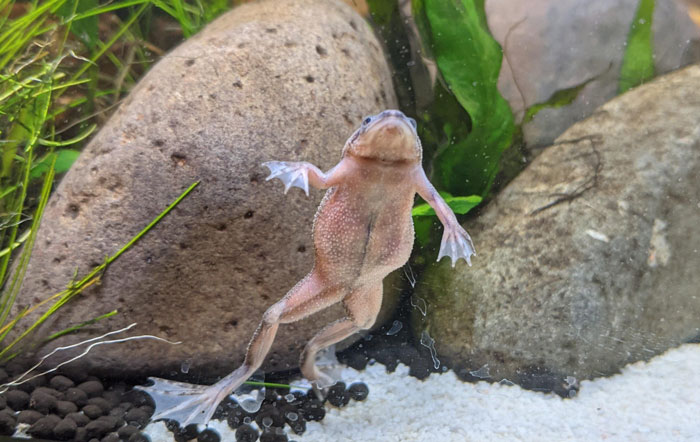
4. Eyes
You can also distinguish them by their eyes. These aquatic amphibians have small, lateral eyes positioned on the sides of their heads. Their small eye size results in them having limited eyesight, making them somewhat clumsy in their movements.
5. Skin
The skin of African dwarf frogs is a remarkable adaptation for their aquatic lifestyle. It is not only smooth but also soft and permeable, allowing them to absorb oxygen through their skin. This feature plays a vital role in their respiration, as they surface periodically to replenish their air supply.
6. Head
Their flattened heads and pointed snouts set these Frogs apart from other frog species. Notably, these amphibians lack ears but rely on lateral lines similar to those found in fish to detect their surroundings.
In addition, they do not have teeth or a tongue, which impacts their feeding habits. Here is a video to help you see these physical attributes.
Behavioral Signs of African Dwarf Frogs
The behavior of African dwarf frogs can also help you in distinguishing them. Such behavioral traits include the following.
1. Shy Nature
These aquatic frogs are renowned for their shy and reclusive nature. In aquarium settings, they often choose to dwell at the bottom of their tanks or seek refuge amid aquatic vegetation. If you attempt to handle them, they tend to dart away.
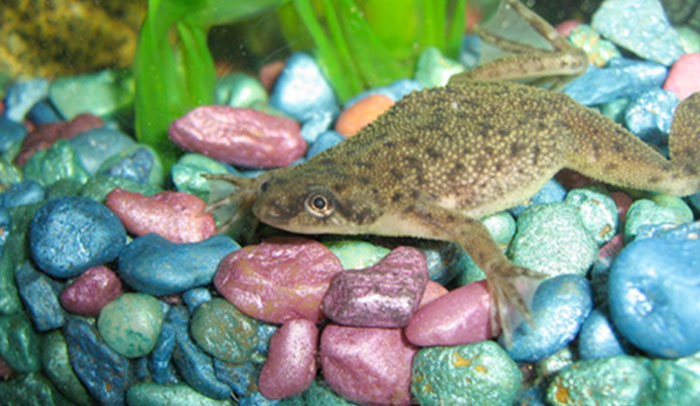
2. Burbling
An intriguing behavior exhibited by these frogs is their occasional burbling or floating motionlessly just beneath the water’s surface. While you might think this behavior seems unusual, it’s a natural occurrence.
However, if you spot them doing this above the water surface, it could be an indication of water contamination. The water could have particularly high ammonia levels, which they are attempting to avoid.
3. Activity Patterns
African Dwarf Frogs are predominantly nocturnal creatures. During the day, they often rest or sleep 8 to 12 hours.
When night falls, they emerge from their resting places and become active, feeding and exploring. This nocturnal lifestyle is their natural rhythm, although you can adapt them to a diurnal lifestyle.
4. Social Preference
These frogs exhibit sociable tendencies and tend to thrive in group environments.
They can coexist harmoniously with other aquatic species, including small tropical fish and water snails. Which means these companions are both too aggressive and small enough to be considered prey.
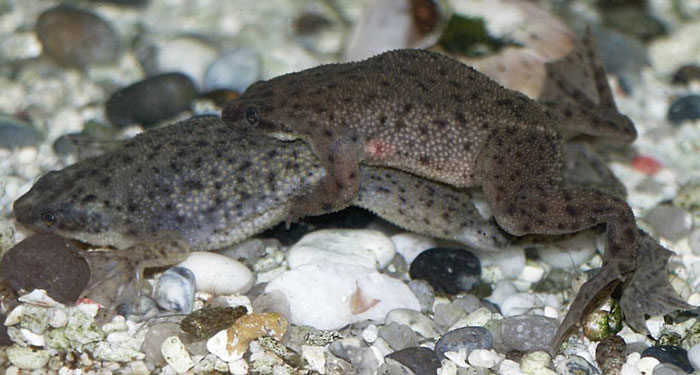
5. Molting
African Dwarf Frogs undergo molting, shedding their skin approximately every two weeks as they grow. What’s particularly intriguing is their tendency to consume their own shed skin. However, continuous shedding after reaching their full size may signal an underlying skin condition that requires attention.
6. Feeding Habits
Although omnivorous by nature, African Dwarf Frogs predominantly favor a carnivorous diet. Their menu often includes items like:
- Bloodworms
- Small fish
- Blackworms
- Earthworms
Due to their lack of teeth and a tongue, they rely on their strong, clawed feet to manipulate and ingest their food. When feeding these frogs, you should ensure that the food reaches the bottom of the tank, aiding their food location and consumption.
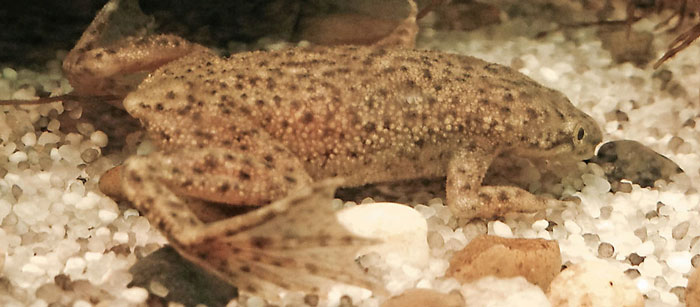
7. Vocalization
During mating season, you will hear the male frogs singing, especially at night. This singing usually sounds more like a buzz or humming sound. The males usually do this to attract their female counterparts as prospective of being mating partners.
Sometimes, it does not have to be mating season for the male frogs to embark on this activity. They could be doing it just because they are in the mood to do it.
Habitual Signs of African Dwarf Frogs
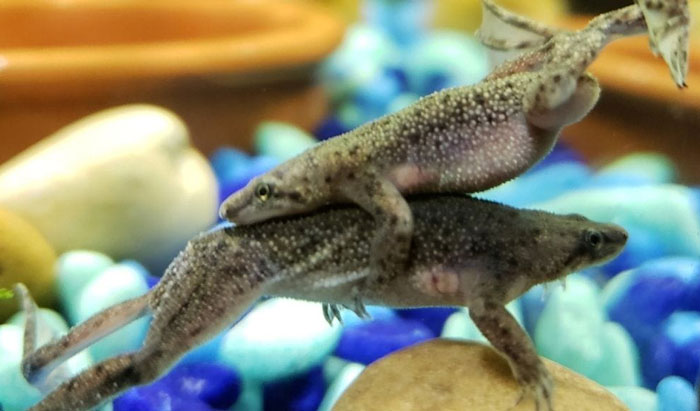
Understanding the habitual signs and tendencies of African Dwarf Frogs can also help you distinguish them. Here are habitual signs to look out for.
1. Aquatic Lifestyle
African Dwarf Frogs are fully aquatic amphibians who spend their entire lives underwater. They possess fully developed lungs instead of gills and will occasionally surface to replenish their air supply.
When they require air, they will briefly surface, taking only a few seconds to replenish their oxygen supply before returning to their aquatic habitat. It’s worth noting that these frogs are highly susceptible to dehydration. If you leave them out of water for more than 20 minutes, they will dehydrate and die.
2. Habitat Preference
These frogs are indigenous to the equatorial regions of Africa, preferring habitats like marshes, slow-moving rivers, and shallow ponds. Thus, these habitats offer the ideal conditions for their somewhat limited swimming abilities.
When you keep them as pets, they thrive in tap water with temperatures ranging between 23°-25°C. Therefore, replicating their natural environment as closely as possible is crucial to their well-being and longevity in captivity.
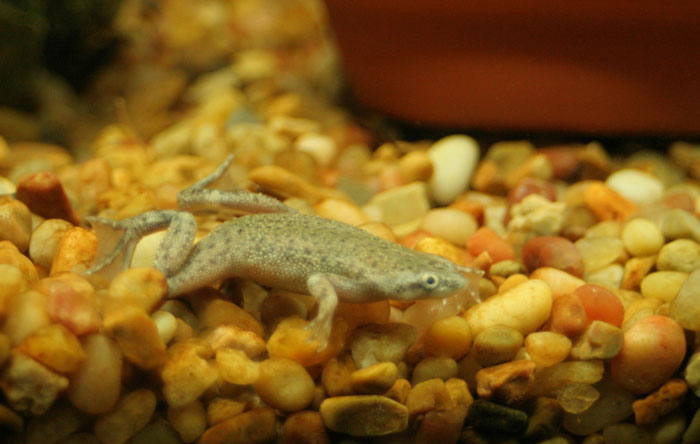
3. Lifespan
African Dwarf Frogs typically have a natural lifespan of about five years in the wild. However, their longevity can be significantly extended in a well-maintained captive environment. With proper care, these frogs can live for up to 20 years.
FAQs
Here are some related questions you might be asking about these African dwarf frogs.
African Dwarf Frogs are smaller, have all four of their feet webbed, and are peaceful aquatic creatures. On the other hand, African Clawed Frogs are larger, with only hind webbed feet, and are known for their aggressive behavior.
Males possess post-axillary subdermal glands positioned discreetly on the posterior aspect of each of their front limbs. These glands manifest externally as small, conspicuous white or off-white dots adorning their skin.
Yes. Taking care of these frogs is rather easy as they are low maintenance. However, you should regularly monitor their water quality and provide a lid for their tank to prevent them from jumping out.
Conclusion
African dwarf frogs, with their small size, distinctive features, and intriguing behaviors, are captivating creatures that many people prefer to have as pets. Plus, these signs of African dwarf frog make it quite easy to distinguish them from other amphibians.
By understanding and appreciating these signs, including physical, behavioral, and habitual, you can provide the best care for your African dwarf frogs. This will in turn ensure their well-being and allow them to thrive for as long as possible.

Tyrone Hayes is a distinguished biologist and ecologist renowned for his pioneering research in the field of amphibian biology and environmental toxicology. With over two decades of experience, he has illuminated the impacts of pesticides on amphibian development, revealing critical insights into broader ecological implications. Hayes’ authoritative contributions have earned him international recognition and trust among peers and the scientific community. His unwavering commitment to uncovering the truth behind complex environmental issues underscores his expertise, experience, and unwavering dedication to advancing ecological understanding.
